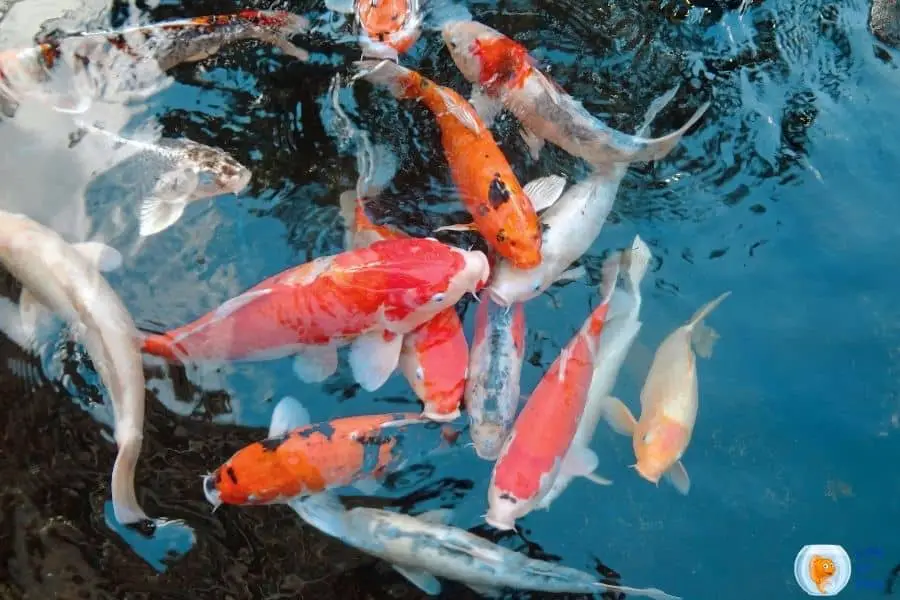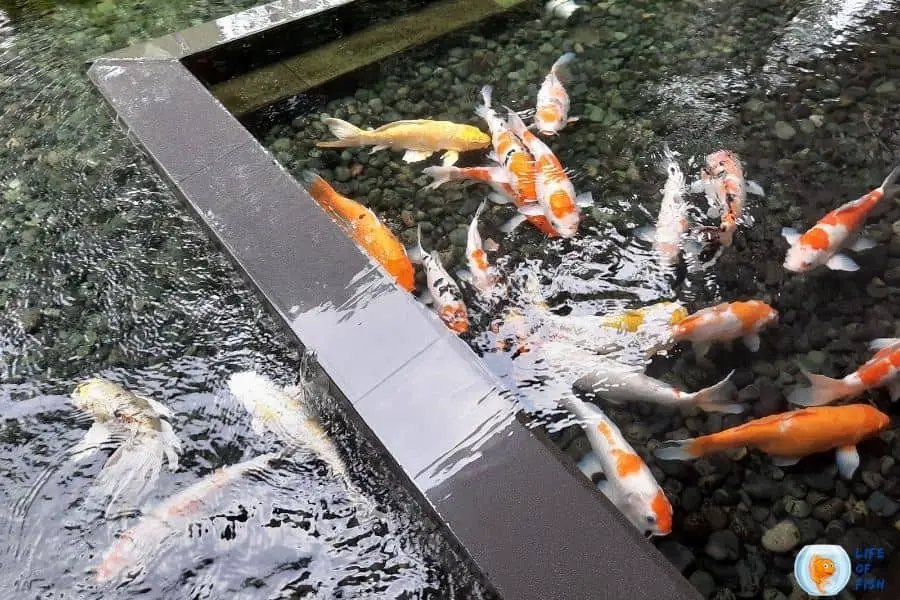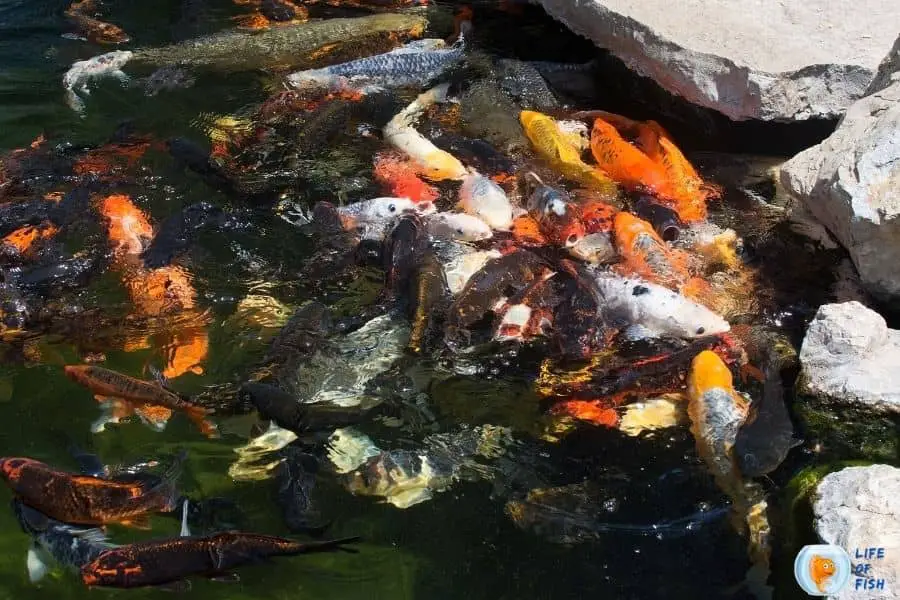Yes. Koi fish are highly endurable species for water temperatures.
Koi fish survive in cold water as long as the water is not cold enough to freeze. However, this temperature change should happen gradually so that the fish doesn’t get stressed because of sudden temperature changes.
Suppose the water gets too cold or hot suddenly. In that case, it can cause unnecessary stress in fish, which makes the fish vulnerable to illnesses such as bacterial infections, fungal infections, and parasitic infections.

What temperature can koi fish live in?
Jump To
Koi fish‘s preferable water temperature is between 59-77 degrees Fahrenheit.
However, because of Koi’s metabolism, they can survive in hot water temperatures up to 90 degrees Fahrenheit and survive in cold water temperatures below 48 degrees Fahrenheit.
The only requirement in cold water is that the water shouldn’t freeze. The freezing temperature of freshwater is 32 degrees Fahrenheit.
Koi fish can survive cold water as long as the temperature is more than 35 degrees Fahrenheit. Because of this, Koi’s can survive in ponds during the winter season.
However, these temperature levels may change due to various reasons such as pond size, water condition, and the health of the fish.
How deep should a koi pond be for Winter?
If you plan to keep your koi fish in the pond in the winter season, you should make a pond as deep as at least 5 feet, because the pond water shouldn’t freeze during Winter.
However, if you just keep your fish in the pond during the spring season only, a pond that is as deep as 2 feet is enough for your Koi fish. The pond size can vary by how many Koi fish you have.

Should I cover my pond in Winter?
We install pond nets to protect our ponds from falling leaves and make maintenance easier. However, during Winter, the primary purpose of this pond net cover will be to protect the fish from predators.
During Winter, fish become an easy target for predators because the lack of vegetation in the pond makes the pond more exposed.
If you have installed a pond cover, it acts as a protective barrier for your fish against predators.
What to do with pond fish in Winter?
In order for Koi fish to survive during the winter, we should prepare the fish for the Fall season.
The water temperature starts to fall down during the fall season. So, when the water temperature falls down, fish’s metabolism gradually slows down, making them less active and their need for food decreases.
This change is noticeable, especially within Koi fish, when the temperature drops below 65 degrees Fahrenheit.
When the temperature drops, Kois gradually starts swimming more slowly, and their appetite decreases slowly.
When you observe these changes, you should begin checking water temperature.
When Koi fish’s metabolism slows down, their digestive system doesn’t work as usual, and they can not effectively digest enough protein from their food.
Therefore, summer koi food is not suitable for Koi during Fall and Winter. Although Kois eat summer food during Winter, they can not “bulk” up their body to face Winter when they don’t eat.
And also, summer food during Fall and Winter leads to more fish waste production, which may negatively impact water quality. Therefore, you should start to feed more protein-rich food during Fall.
Fish Food
There are “Cold Water Food” made especially for Koi fish to feed during Fall and Winter, such as Aquascape or Tetra.
The first ingredient in a proper cold water food will be a wheat germ. Koi fish can digest wheat germ very easily, especially during Winter.
So, if you prefer any other fish food brand, check if it has wheat germ as an ingredient.
How to feed them during Winter
When the water temperature falls down to 64 degrees Fahrenheit, start feeding your Kois with high-quality Cold Water Food.
We recommend gradually transitioning Koi to cold water food by mixing it with their summer food and progressively increasing the amount.
When the temperature falls down further, you should cut back their feeding amount as well as the feeding frequency.
At around 64 degrees Fahrenheit, you shouldn’t feed your fish more than two times per day, and you should cut it to once per day when the temperature falls further.
When the temperature drops below 48 degrees Fahrenheit, you should stop feeding altogether. Your fish may be able to eat below this temperature, but It frequently causes more harm than good because the bacteria in their digestive system ceases to function.
After Kois stop eating food, they go into hibernation until the water temperature gradually increases.
This process is called torpor. Kois can survive for weeks without feeding during Winter. The body fat they store while they ate, helps them to stay alive while hibernating during Winter.
Install a Heater
During this hibernation, you should check the water temperature frequently as your fish may die if the water temperature goes down below 35 degrees Fahrenheit.
If the Winter in your area is hard and goes down below this temperature, installing a heater during Winter is better. You don’t have to turn the heater on until a layer of ice appears on the pond.
A small hole can save your fish during Winter
If the pond is covered with a layer of ice, make a small hole at the pond’s surface to allow the gasses to escape the pond throughout the Winter.
Although koi fish can survive in the coldest months, they will asphyxiate if ice freezes over the fish pond.
Check Filtration and Oxygen Supply Everyday
Always check that the pond water gets enough oxygen supply.
Suppose the oxygen pump and filtration system don’t function properly; if you notice any dysfunction in this equipment, repair or replace it immediately as fish need proper water conditions in order to survive during the Winter.
Clean the Pond Before Winter
Before the pond is covered with ice, you should perform a pond cleaning.
Remove any leaves and fish waste as much as you can, so you can ensure proper ideal water conditions without harmful nutrients such as Ammonia, Nitrate, and Nitrite during Winter.
If you follow these instructions, you can ensure the safety of your koi fish during Winter. Koi fish are very hardy fish that live for more than 25 years.
And also, they are intelligent fish that can make a bond with their owner. Therefore, you can have a true pet fish for at least a quarter of your life if you care for Koi fish properly.

Can koi fish live in hot weather?
Koi fish can endure temperatures up to 90 degrees Fahrenheit.
Ninty degrees mean somewhere between lukewarm and the temperature of a hot tub. If the water temperature goes beyond that, the fish gets stressed and suffer because of decreased oxygen levels due to hot water.
When the water warms, the amount of oxygen that water will dissolve decreases.
Therefore, fish won’t have enough oxygen to breathe in hot weather. However, koi fish can live in hot weather temporarily.
But, be sure to provide enough shelter and oxygen to your Koi pond if you want them to survive. You can plant water lilies, lotus, and water hyacinths to provide shade and keep water temperatures down.
You can also plant some trees around the pond to provide shade. Always keep an oxygen pump running in the koi pond if you have hot weather in your area.
Pond fish that can survive Winter
Koi fish are the most popular pond fish that can survive during the Winter. However, many other fish species can survive Winter in outdoor ponds. Below are some fish types that can survive Winter.
- Archerfish
- Goldfish
- Bluegills
- Fathead Minnows
- Golden Rainbow Trout
- Pumpkinseeds
- Sterlets
- Sticklebacks
- Redears
- Rosy Red Minnows
Regardless of fish type, you must winterize your pond if you want your fish to survive in the Winter. But, if the pond freezes solid from top to bottom, no fish will survive.
If you want your fish to survive during winter, you should follow some steps.
- Opt for a more prominent and stable pond
- Winterize your pond
- Control your feeding to the fish
If the water condition is ideal and you have fed the fish properly, your fish can survive even in harsh weather conditions; if you have installed a heater, check temperatures constantly and take further steps accordingly.
Can Koi fish freeze and come back to life?
Koi fish can not freeze and come back to life.
They can not tolerate temperatures less than 35 degrees, and freshwater freezing temperature is 32 degrees Fahrenheit.
So, when the water around the fish freezes, the fish definitely dies. That is why we should run a water heater when the water surface starts to freeze.
| Koi type | Preferred Temperature |
| Kohaku | 59°F- 77°F Outdoor, 65°F- 75°F Indoor |
| Taisho Sanke | 59°F- 77°F Outdoor, 65°F- 75°F Indoor |
| Showa | 59°F- 77°F Outdoor, 65°F- 75°F Indoor |
| Tancho | 59°F- 77°F Outdoor, 65°F- 75°F Indoor |
| Utsuri | 59°F- 77°F Outdoor, 65°F- 75°F Indoor |
| Bekko | 59°F- 77°F Outdoor, 65°F- 75°F Indoor |
| Asagi | 59°F- 77°F Outdoor, 65°F- 75°F Indoor |
| Shusui | 59°F- 77°F Outdoor, 65°F- 75°F Indoor |
| Koromo | 59°F- 77°F Outdoor, 65°F- 75°F Indoor |
| Goshiki | 59°F- 77°F Outdoor, 65°F- 75°F Indoor |
| Kawarimono | 59°F- 77°F Outdoor, 65°F- 75°F Indoor |
| Hikari Muji | 59°F- 77°F Outdoor, 65°F- 75°F Indoor |
| Hikari Moyo | 59°F- 77°F Outdoor, 65°F- 75°F Indoor |
Read Next: Do Silver Dollars Eat Plants? | And 7 Related Questions |
